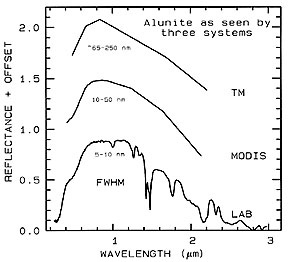

Hyperspectral Remote Sensing: Imaging Spectrometers
Beginning in the 1980s, Dr. Alexander F.H. Goetz and his colleagues at the Jet Propulsion Laboratory began a revolution in remote sensing by developing a powerful new instrument called AVIRIS (for Airborne Visible-Infra Red Imaging Spectrometer).* This instrument took advantage of new detector technology to extend ground-based spectrometers into the air on moving platforms. Thus, the distinct value of obtaining hyperspectral curves has made it possible to acquire detailed data on the materials and classes present on the Earth's (or other planets) surfaces. Essentially these curves are continuous spectral plots that measure reflectances from the ground, water, or the atmosphere in the wavelength region responding to solar illumination (Visible-NearIR-Shortwave IR). The plots also record the fine-details of absorption phenomena. With these hyperspectral curves, we can now do rigorous analysis of surface compositions over large areas. Moreover, we can display the data either as spectral curves with detail similar to those on the preceding page, or as images similar to those obtained by Landsat, SPOT, etc. With spectral curves we capture the valuable information associated with diagnostic absorption troughs, and with images we get relatively pure scenes, colorized (through color compositing) from intervals that represent limited color ranges in the visible or in false color for the near-IR (NIR).We construct the images from variations in reflectance, covering very narrow bands (e.g., 0.01 micrometers). As an example, consider this pastoral scene produced as a true color image from data obtained by another imaging spectrometer (AVIRISwiss'91).
13-16: So, once again, in your own words: What is/are the main advantage(s) of hyperspectral remote sensing? ANSWER
As they gained experience operating AVIRIS, they built other imaging spectrometers, using different spectral dispersion devices, detector sizes, and other variables. We shall discuss the basics of instrument design later, along with a list of many of these operational spectrometers. As a result a large number of service organizations have emerged or expanded to offer hyperspectral remote sensing from aircraft as a commercial product. By the turn of the millenium, imaging spectrometers will enter space. At one point, the Space Shuttle manifest included a spaceborne version of AVIRIS, known as SISEX, but it fell victim to technological and budgetary constraints. A HyperSpectral Imager (HSI) launched in 1997 onboard the Lewis satellite, but that system failed to reach a functional orbit.
The obvious improvements in information content gained by operating a spectrometer from air/space platforms are evident in this plot of the spectral response for the mineral Alunite (potassium-aluminum sulphate). MODIS is an instrument that launched with the EOS missions in 1999 (see Section 16).

Before describing these various imaging spectrometers and examining imagery and applications associated with them, we need to take a more extensive look into the fundamentals of spectroscopy than we presented in the Introduction of this tutorial. To do this, we provide, in the next few pages, a condensation of a valuable review produced by a leading spectrometrist, Dr. Roger N. Clark of the U.S. Geological Survey. ___________________________________________________________
* A benchmark paper at the outset of imaging spectroscopy's appearance as a viable remote-sensing tool is: Goetz, A.F.H, G. Vane, J.E. Solomon, and B.N. Rock, 1985, Imaging Spectroscopy for Earth Remote Sensing, Science, v. 228, pp. 1147-1153.

Primary Author: Nicholas M. Short, Sr. email: nmshort@epix.net
Collaborators: Code 935 NASA GSFC, GST, USAF Academy
Contributor Information
Last Updated: September '99
Webmaster: Bill Dickinson Jr.
Site Curator: Nannette Fekete
Please direct any comments to rstweb@gst.com.